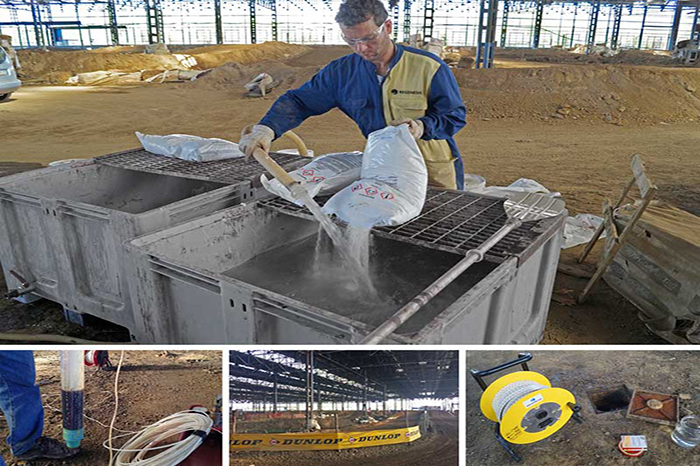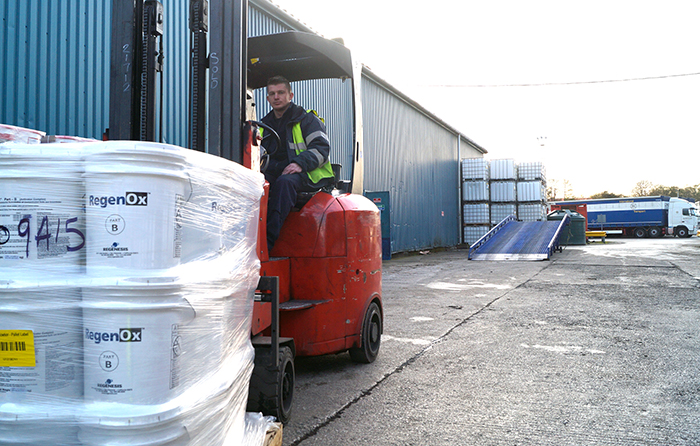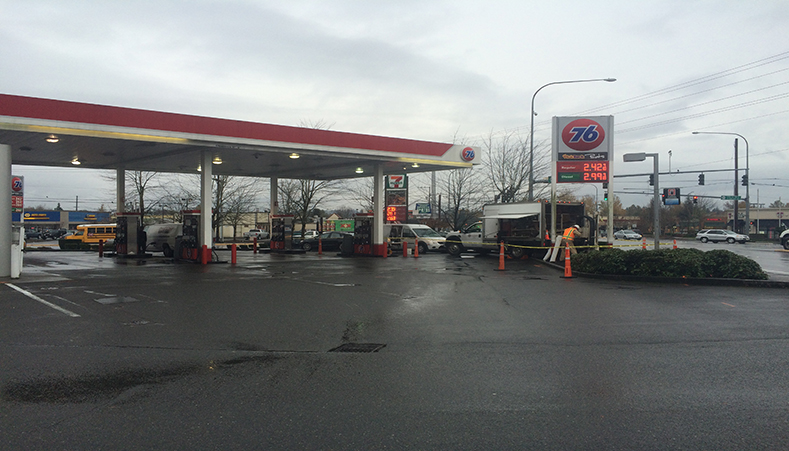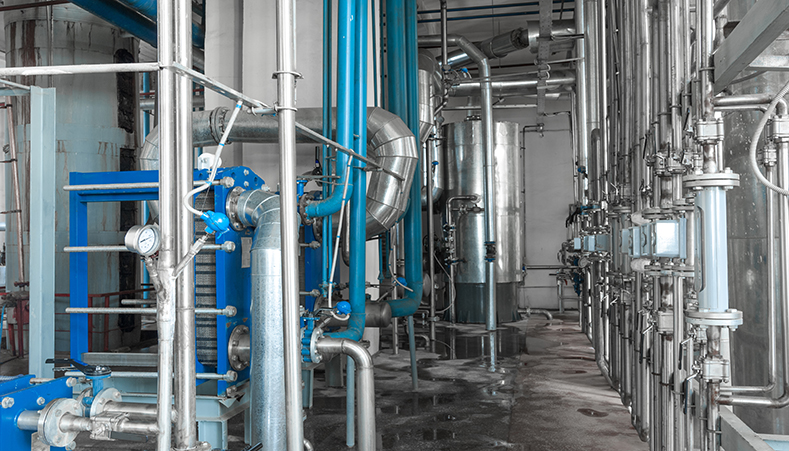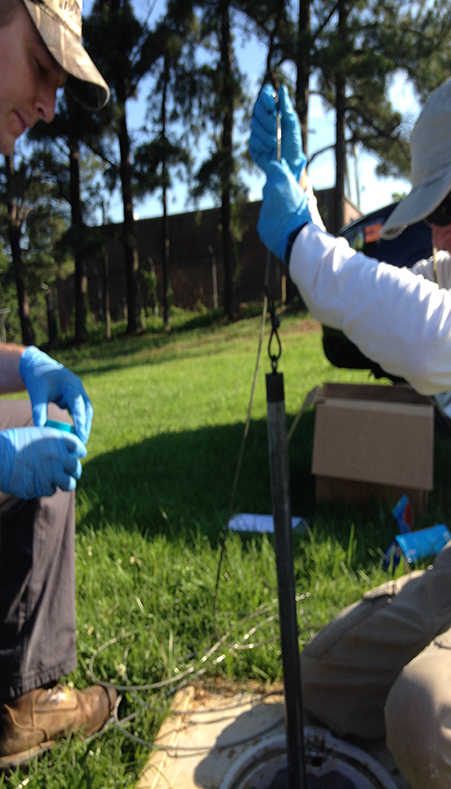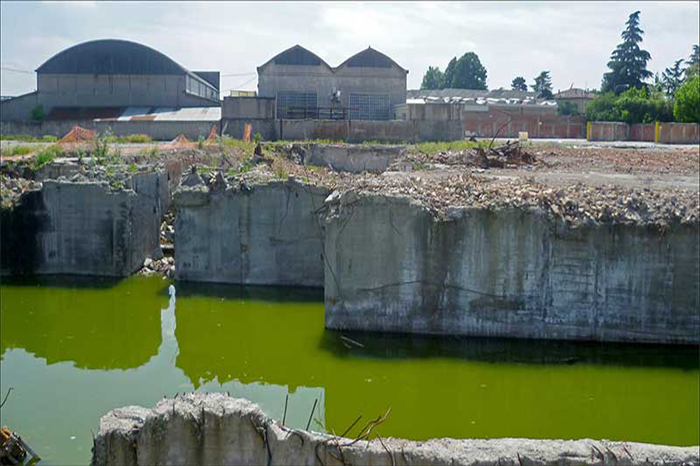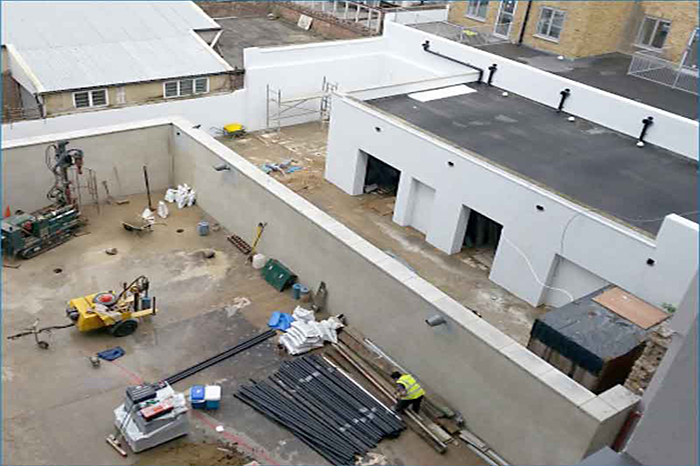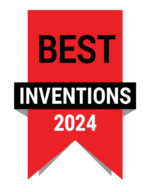Treatment of a Widespread Plume Beneath a Metropolitan Area in Italy
A widespread plume of chlorinated solvents (CHC) has been monitored for more than a decade underneath the train station and extending out under the surrounding urban area of Bologna, Italy. The intention on this site was to treat all of the accessible ‘hot spots’ present within the plume, with the first area being used as a pilot test to confirm dose and distribution.Read More
LNAPL Removal at a Former Manufacturing Site, Northwest Italy
Enhanced chemical desorption using PetroCleanze is being implemented at the site, in order to reduce the viscosity and mobilise the oil, for a subsequent mass removal using a vacuum truck system.Read More
Remediation of a Diesel Plume at an Active Rail Facility in Yorkshire, UK
Enhanced Natural Attenuation of a TPH Plume using ORC Advanced as part of an integrated treatment train solution provided by AECOM.Read More
Remediation of Chlorinated Hydrocarbons at Manufacturing Facility, UK
AECOM successfully applied a phased treatment train solution for chlorinated solvents under an operational manufacturing facility. After an initial Dual Phase Extraction (DPE) phase, REGENESIS and AECOM devised a remedial design based on the updated Conceptual Site Model including In Situ Chemical Oxidation (ISCO) using RegenOx®, and Enhanced Reductive Dechlorination (ERD) using HRC®, to treat the residual contamination in groundwater.
Read More
Innovative Combined Amendment Approach Successfully Applied to Treat PHC Levels
Project Highlights
- Site previously treated with a series of RegenOx® and ORC Advanced® amendments significantly reduces plume concentrations. Remaining hot spot was then treated with turn-key injection application of PersulfOx® and ORC Advanced technologies bringing closure to facility
- Successful turn-key treatment of offsite hot spot completed within five days

Project Summary
An active gas station, identified by the State of Washington Department of Ecology as one of five LUST sites within one mile of Vancouver’s three groundwater monitoring wells, had entered into the state’s Voluntary Cleanup Program (VCP) in 2006 subsequent to shutdown of the onsite air-sparge/vapor extraction (AS/VE) system. This system had historically been employed at the site to supply oxygen for remedial purposes and address subsurface contamination that was first discovered beneath the dispenser islands in 1993. While prior applications of RegeneOx and ORC Advanced were effective in mitigating onsite contamination, PHC levels remained above MTCA criteria offsite hindering achievement of regulatory closure.
Antea® Group—the environmental consulting firm charged with remediation—partnered with REGENESIS® to implement a remedial strategy and technical design, which included the turn-key injection application of PersulfOx and ORC Advanced technologies to address petroleum hydrocarbons (PHCs) using an in situ chemical oxidation (ISCO) and enhanced aerobic remediation approach. The hot spot injection application included one event of PersulfOx coapplied with ORC Advanced, using direct push technology (DPT) injection points throughout the 3200 sq. ft. treatment area through 40 DPT injection points.
Technology Description
RegenOx – An injectable two-part advanced in situ chemical oxidation (ISCO) reagent that combines a solid sodium percarbonate-based alkaline oxidant (Part A) with a liquid mixture of sodium silicates, silica gel and ferrous sulfate (Part B), resulting in a powerful technology that treats and destroys a wide range of target contaminants including both petroleum hydrocarbons and chlorinated compounds.
PersulfOx – An advanced ISCO reagent and all-in-one product with a built-in patented catalyst destroys organic contaminants found in groundwater and soil through abiotic chemical oxidation reactions.
ORC Advanced – An engineered, oxygen-release compound designed specifically for enhanced, in situ aerobic bioremediation of petroleum hydrocarbons in groundwater and saturated soils. ORC Advanced produces a controlled release of molecular oxygen accelerating aerobic biodegradation processes up to 100 times f aster than natural degradation rates.
Results
For the final application event, following five on-site working days, REGENESIS completed the hot spot application process during which 9,753 lbs. of PersulfOx and 2,240 lbs. of ORC Advanced were applied to the designated treatment area. First quarter sampling results post-application showed concentrations below MTCA criteria. Following three quarters of monitoring, remediation of this site will be complete.
About the Client
Antea Group is an international engineering and environmental consulting firm specializing in full-service solutions in the fields of environment, infrastructure, urban planning and water. With more than 3,000 employees in over 100 offices around the world, Antea Group serves clients ranging from global energy companies and manufacturers to national governments and local municipalities.
Efficient Application of Combined Amendments Reduces PHC Concentrations Below Washington MCTA Levels
Project Highlights
- In Situ injection application of PlumeStop® Liquid Activated Carbon™ and ORC Advanced® brings closure to facility identified as Leaking Underground Storage Tank (LUST) site
- REGENESIS® Remediation Services (RRS) used a multi-point approach to efficiently inject the combined amendments, completing the application within 24 hours
- PHCs in groundwater and soil reduced below Washington Department of Ecology’s Model Toxics Control Act (MTCA)
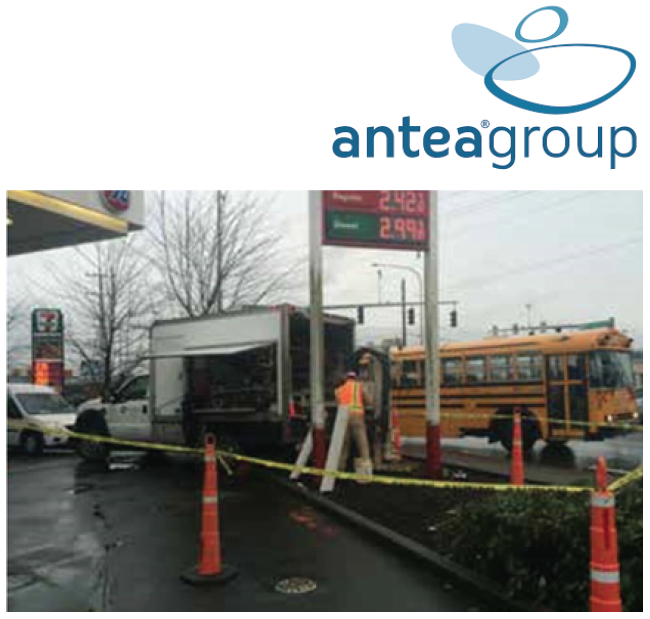
Project Summary
An active gas station in Bothell, Washington was listed as a LUST site by the State of Washington Department of Ecology after two subsurface investigations detected petroleum hydrocarbon (PHC) impacted soil and groundwater. Entering into the state’s Voluntary Cleanup Program (VCP) in 2001, the site continuously failed to meet regulatory requirements defined in the MTCA, despite several years of cleanup efforts using a soil vapor extraction (SVE) system and an air sparge (AS) system to remove contaminant concentrations from beneath the site. Charged with remediation, Antea® Group partnered with REGENESIS to implement a solution, which included in situ injection applications of PlumeStop and ORC Advanced technologies.
REGENESIS injected approximately 200 gallons of PlumeStop using strategically placed point locations to rapidly reduce contaminant concentrations. Direct Push Technology (DPT) was employed to advance injection points throughout the treatment zone. The following day, the solution was increased, for a total of 835 gallons of PlumeStop solution (as applied with water) injected within the targeted treatment interval to deliver the full volume of remediation ammendment and complete the application on schedule. A total of nine (9) PlumeStop DPT injection points were cleared to 5 ft. bgs pre-injection.
Additionally, 120 lbs. of ORC Advanced were applied in cleared boreholes via a backfilling method, which involved drilling to the target depth, retracting the rods and pouring the ORC Advanced slurry down open boreholes to approximately 5 ft. bgs in order to properly abandon points.
Technology Description
PlumeStop – An innovative groundwater remediation technology designed to address the challenges of excessive time and end-point uncertainty in groundwater remediation. PlumeStop is composed of very fine particles of activated carbon (1-2μm) suspended in water through the use of unique organic polymer dispersion chemistry. Once in the subsurface, the material behaves as a colloidal biomatrix binding to the aquifer matrix, rapidly removing contaminants from groundwater, and enhancing permanent contaminant biodegradation.
ORC Advanced – An engineered, oxygen-release compound designed specifically for enhanced, in situ aerobic bioremediation of petroleum hydrocarbons in groundwater and saturated soils. ORC Advanced produces a controlled release of molecular oxygen accelerating aerobic biodegradation processes up to 100 times f aster than natural degradation rates.
Results
During the course of the injection and at the end of the application, increases in groundwater levels, ORP (oxidation reduction potential), and dissolved oxygen were observed in monitoring wells in the treatment area. The successful application of both technologies was achieved within approximately 24 hours, despite the challenging glacial till geology known to the region. With field modifications, RRS was able to not only mitigate surfacing issues by switching to injection via injection-well application, but also achieve the desired distribution of the remediation substrate in the subsurface. The first quarter sampling results indicate that the contaminant concentrations are at non-detect. Following monitoring events over the next three quarters, this site will be closed and issued a No Further Action (NFA) from the Washington Department of Ecology.
About the Client
Antea Group is an international engineering and environmental consulting firm specializing in full-service solutions in the fields of environment, infrastructure, urban planning and water. With more than 3,000 employees in over 100 offices around the world, Antea Group serves clients ranging from global energy companies and manufacturers to national governments and local municipalities.
HRC Barrier Applied Successfully Reduces TCE Levels to Non-Detect in Fractured Bedrock Site
Project Highlights
- Based on successful pilot test results, full-scale implementation of HRC barrier was applied
- TCE levels reduced by 99% within one year & at non-detect levels within 18 months
- Innovative design was effective in addressing contaminants of concern

Project Summary
At a manufacturing facility in Virginia, HRC® was injected into a crystalline bedrock aquifer contaminated with TCE and its daughter products. The industrial site had been in operation for over 30 years. Groundwater flow was controlled by fractures in the crystalline rock with little to no permeability present beyond these fractures. Contamination levels had reached a high of 220 ppb of TCE. REGENESIS® recommended an HRC pilot test in conjunction along with excavation of the impacted geology.
The design using an HRC barrier focused on reducing TCE concentrations within a bedrock formation. Injection of HRC was accomplished using a single and double packer array and an appropriate delivery pump. The packer application method allowed HRC to be focused on the fractures controlling groundwater flow. A single packer system was used to apply HRC to the lower fracture (32 ft. bags) and a double packer system was used to apply HRC to the upper fracture zone (22-28 ft. bags). HRC was effectively injected at volumes ranging from 120-160 pounds per injection well.
Technology Description
HRC® is an engineered, hydrogen release compound designed specifically for enhanced, in situ anaerobic bioremediation of chlorinated compounds in groundwater or highly saturated soils.
Results
Over a period of less than a year, TCE concentrations decreased from 220 ug/L to 3 ug/L (a 99% reduction) and within 18 months, were at non-detect levels. Over the same period, concentrations of daughter products DCE and VC initially increased as expected (due to sequential reductive de-chlorination) but then subsequently decreased. In addition, concentrations of the de-chlorination end product, ethene, increased by 10x during the same time frame. The pilot test resulted in favorable results and continued through full-scale implementation. HRC’s proven effectiveness at treating chlorinated solvents within the fractured bedrock system and its significant cost advantage over all other technologies allowed the environmental firm to select HRC for their full-scale implementation resulting in reducing concentrations to non-detect and meeting site goals.
Back Diffusion of VOCs from a Fractured Sandstone Aquifer Treated at Former Industrial Facility
Project Highlights
Large-scale pilot tests confirm management of chlorinated VOC back diffusion from fractured bedrock aquifer
- Tests concluded degradation along biotic and abiotic reductive pathways
- Advanced sorbent technology extends treatment longevity to manage to manage long-term back diffusion
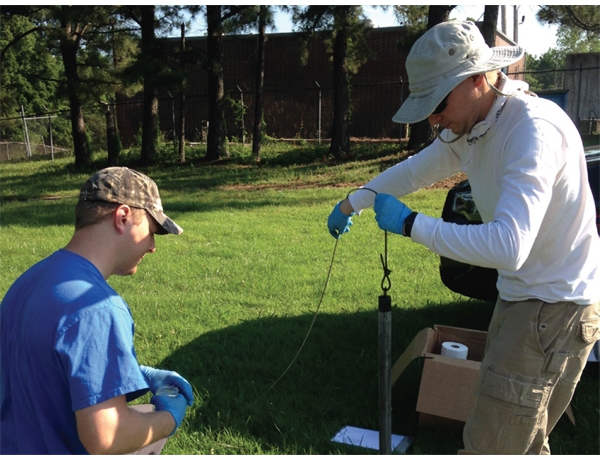
Project Summary
Fractured bedrock aquifers can be extremely heterogeneous which not only results in complex dissolved plume behavior, but can also hinder in situ remediation efforts that rely on an injection of amendments to promote microbial activity and abiotic degradation. However, due to the potentially high cost of a pump and treat remedy at a former industrial site in Arkansas, WSP determined that an in situ pilot test with advanced substrates was warranted.
At the Arkansas site, a 2016 pilot study was conducted using a multifunctional amendment formulation. REGENESIS® 3D-Microemulsion®, BDI Plus®, and CRS® were injected to remediate affected groundwater within a fractured sandstone bedrock aquifer impacted by chlorinated solvents. The contaminants at the site included trichloroethene (TCE), 1,1,1-trichloroethane (TCA), and degradation products. The plume on site underlies several developed properties and threatens a stream located approximately 1,500 feet from the source area. Results of the first pilot study yielded an 82% reduction within 9 months was measured approximately 80 feet from the application location.
A second pilot study was undertaken in 2017 to emplace a sorbent technology with long-lasting treatment capacity (PlumeStop®) on bedrock fracture faces to manage back diffusion from the bedrock primary porosity. This test also included the addition of bioremediation amendments to permanently degrade the sorbed contaminants. The 2017 treatment included PlumeStop and bioremediation amendments. After only one month, an 81% reduction was achieved in samples located 50 feet downgradient.
Preliminary indications of these amendment formulation tests are extremely promising in treating contaminant back diffusion emanating from the fractured bedrock matrix in this aquifer. WSP is confident that favorable performance monitoring results will continue and the full-scale remedy for this complex geologic setting will include REGENESIS products that extend treatment longevity.
Technology Description
PlumeStop® is an innovative groundwater remediation technology designed to address the challenges of excessive time and end-point uncertainty in groundwater remediation.
3-D Microemulsion® is an engineered electron donor material that offers a novel three-stage electron donor release profile, pH neutral chemistry, and is delivered on-site as a factory emulsified product.
HRC® is an engineered, hydrogen release compound designed specifically for enhanced, in situ anaerobic bioremediation of chlorinated compounds in groundwater or highly saturated soils.
BDI Plus® is designed for use at sites where chlorinated contaminants are present and unable to be completely biodegraded via the existing microbial communities.
CRS® is a liquid iron-based reagent for the enhanced biogeochemical in situ chemical reduction (ISCR) of chlorinated contaminants.
Treatment of a Diverse Range of Contaminants, Emilia Romagna, Italy
Treatment of a very low permeability geology with mixed contaminants at varying concentrations, using multiple application methods and a range of different REGENESIS products.Read More
Remediation of LNAPL at Redevelopment Site – London, UK
A 99% reduction of LNAPL has been achieved within 2 months on this urban site with existing structures and buildings.Read More

 Americas
Americas Europe
Europe Français
Français Deutsch
Deutsch Italiano
Italiano Español
Español
